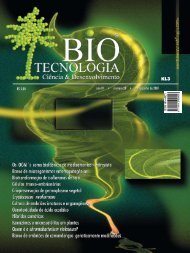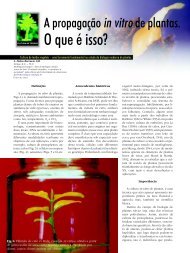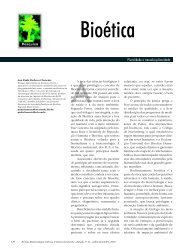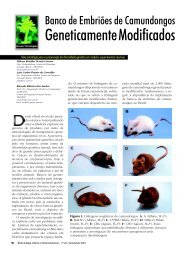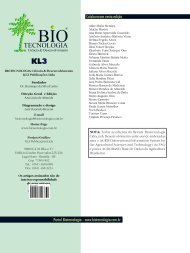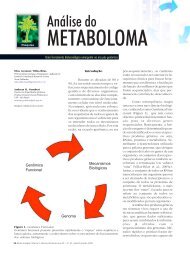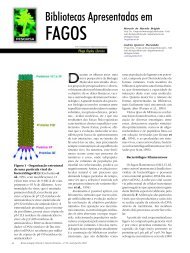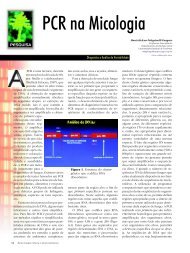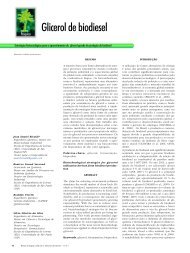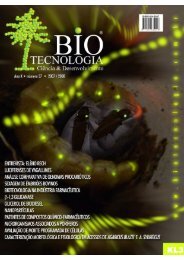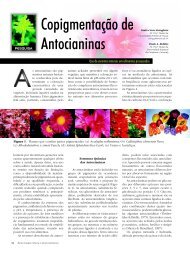Aprendendo com as agrobacterias - Biotecnologia
Aprendendo com as agrobacterias - Biotecnologia
Aprendendo com as agrobacterias - Biotecnologia
You also want an ePaper? Increase the reach of your titles
YUMPU automatically turns print PDFs into web optimized ePapers that Google loves.
mostraram que promotores específicos<br />
para fígado, em vez de promotores<br />
celulares fortes, podem aliviar a<br />
ativação do sistema imune do<br />
hospedeiro, sugerindo que a resposta<br />
imune está relacionada <strong>com</strong> a<br />
transdução de célul<strong>as</strong> apresentador<strong>as</strong><br />
de antígeno 16 . B<strong>as</strong>eado nesses<br />
resultados, foram construídos vetores<br />
contendo, além dos promotores<br />
universais CMV e EF-1a, promotores<br />
específicos de fígado, HAAT e F8p<br />
(Figura 1).<br />
Vetores lentivirais e<br />
pl<strong>as</strong>midiais foram construídos <strong>com</strong><br />
diferentes tipos de promotores, para<br />
observar a especificidade dos<br />
promotores em linhagens celulares de<br />
fígado. Em tod<strong>as</strong> <strong>as</strong> construções<br />
realizad<strong>as</strong> foram utilizado o cDNA do<br />
FVIII sem o dominio B (Figura 1).<br />
No momento, estes vetores<br />
estão sendo testados em cultur<strong>as</strong><br />
celulares para posteriormente serem<br />
aplicados em estudos in vivo.<br />
Considerações finais<br />
O crescente interesse em se<br />
entender os mecanismos de regulação<br />
da secreção e função do fator VIII<br />
leva à realização de experimentos<br />
engenhosos que <strong>com</strong>binam<br />
abordagens de bioquímica e<br />
engenharia genética, trazendo<br />
informações inusitad<strong>as</strong> sobre esse fator<br />
de coagulação sanguínea. Apesar<br />
dos avanços no desenvolvimento de<br />
vetores mais seguros e n<strong>as</strong> técnic<strong>as</strong><br />
de transferência gênica, a resposta<br />
imunológica do hospedeiro contra o<br />
transgene, <strong>as</strong> dificuldades de<br />
produção em larga escala e sua<br />
padronização, ainda são grandes<br />
barreir<strong>as</strong> para seu uso clínico.<br />
Estabelecer linhagens celulares<br />
de mamíferos transformad<strong>as</strong><br />
<strong>com</strong> construções re<strong>com</strong>binantes contendo<br />
o FVIII que expressem a proteína<br />
em níveis elevados será um p<strong>as</strong>so<br />
fundamental para novos avanços<br />
na terapêutica da hemofilia e na caracterização<br />
dos processos envolvidos na<br />
biossíntese do fator VIII. Isto permitirá<br />
também estabelecer, no Br<strong>as</strong>il, a<br />
metodologia para a produção de<br />
fatores de coagulação através de tecnologia<br />
de DNA re<strong>com</strong>binante.<br />
Referênci<strong>as</strong> bibliográfic<strong>as</strong><br />
1- Gitschier J et al (1984). Characterization<br />
of the human factor VIII gene.<br />
Nature 312:326-330.<br />
2- Toole J.J. et al (1984) Molecular<br />
cloning of a cDNA encoding human<br />
antihaemophilic factor. Nature<br />
312:342-347.<br />
3- Vehar G.A. et al (1984) Structure of<br />
active human factor VIII. Nature<br />
312:3 3 7-342.<br />
4- Kaufman R.J et al (1989) Effect of<br />
von Willebrand Factor Coexpression<br />
on the Synthesis and Secretion of<br />
Factor VIII in Chinese Hamster<br />
Ovary Cells. Mol. Cell Biol. 9:1233-<br />
1242.<br />
5- Yonemura et al., 1993. Efficient production<br />
of re<strong>com</strong>binant human factor<br />
VIII by co-expression of the<br />
heavy and light chains. Protein Eng.<br />
1993 Aug;6(6):669-74.<br />
6- Kjalke et al., 1995. Amino acid<br />
residues 721-729 are required for<br />
full factor VIII activity. Eur J Biochem.<br />
1995 Dec 15;234(3):773-9.<br />
7- Burke et al (1986) The functional<br />
domains of coagulation factor VIII:C.<br />
J. Biol. Chem. 261:12574-12578<br />
8- Hoeben et al (1993). Toward gene<br />
therapy in haemophilia A:<br />
retrovirus-mediated transfer of a<br />
factor VIII gene into murine<br />
haematopoietic progenitor cells.<br />
Thromb Haemost. 1992 Mar<br />
2;67(3):341-5.<br />
9- Zatloukal K et al, 1994. In vivo<br />
production of human factor VII in<br />
mice after intr<strong>as</strong>plenic implantation<br />
of primary fibrobl<strong>as</strong>ts transfected<br />
by receptor-mediated, adenovirusaugmented<br />
gene delivery. Proc Natl<br />
Acad Sci U S A. 1994 May<br />
24;91(11):5148-52<br />
10- Chuah et al, 2000,<br />
11- VandenDriessche et al, 1999. Longterm<br />
expression of human coagulation<br />
factor VIII and correction<br />
of hemophilia A after in vivo<br />
retroviral gene transfer in factor<br />
VIII-deficient mice. Proc Natl<br />
Acad Sci U S A. 1999 Aug<br />
31;96(18):10379-84.<br />
12- Dwarki VJ et al, 1995. Gene therapy<br />
for hemophilia A: production of<br />
therapeutic levels of human factor<br />
VIII in vivo in mice. Proc Natl Acad<br />
Sci U S A. 1995 Feb 14;92(4):<br />
1023-7.<br />
13- Chuah MK, et al, 2000. Long-term<br />
persistence of human bone marrow<br />
stromal cells transduced with factor<br />
VIII-retroviral vectors and transient<br />
production of therapeutic levels of<br />
human factor VIII in<br />
nonmyeloablated immunodeficient<br />
mice. Hum Gene Ther. 2000 Mar<br />
20;11(5):729-38<br />
14- Gallo-Penn AM et al, 2001. Systemic<br />
delivery of an adenoviral vector<br />
encoding canine factor VIII results<br />
in short-term phenotypic correction,<br />
inhibitor development, and<br />
biph<strong>as</strong>ic liver toxicity in hemophilia<br />
A dogs. Blood. 2001 Jan 1;97(1):107-<br />
13.<br />
15- Naldini L et al, 1996. Efficient transfer,<br />
integration, and sustained<br />
long-term expression of the<br />
transgene in adult rat brains injected<br />
with a lentiviral vector. Proc<br />
Natl Acad Sci U S A. 1996 Oct<br />
15;93(21):11382-8.<br />
16- P<strong>as</strong>tore L at al, 1999. Use of a<br />
liver-specific promoter reduces<br />
immune response to the transgene<br />
in adenoviral vectors. Hum Gene<br />
Ther. 1999 Jul 20;10(11):1773-81.<br />
17- Naldini L et al (1996). In vivo<br />
gene delivery and stable transduction<br />
of nondividing cells by a<br />
lentiviral vector. Science. 1996 Apr<br />
12;272(5259):263-7.<br />
18- Park F et al (2000). Therapeutic<br />
levels of human factor VIII and<br />
IX using HIV-1-b<strong>as</strong>ed lentiviral<br />
vectors in mouse liver. Blood. 2000<br />
Aug 1;96(3):1173-6.<br />
19- Herder et al (2003). Sustained Expansion<br />
and Transgene Expression<br />
of Coagulation Factor VIII- Transduced<br />
Cord Blood- Derived Endothelial<br />
Progenitor Cells. Arterioscler<br />
Thromb V<strong>as</strong>c Biol. Dec 23 (12)<br />
2266-72.<br />
20- Tonn T et al. Generation and<br />
characterization of human hematopoietic<br />
cell lines expressing factor<br />
FVIII. Journal of Hematotherapy<br />
& Stem Cell. 2002 Aug. 11(4) ; 695-<br />
704<br />
21- Becker S et al. Confocal microscopy<br />
analylis of native, full lengh and<br />
B-domain deleted coagulation factor<br />
VIII trafficking in mammalian<br />
cells. Artigo aceito pela revista<br />
Thromb. Hemost.<br />
<strong>Biotecnologia</strong> Ciência & Desenvolvimento n.32 - janeiro/junho 2004 83



